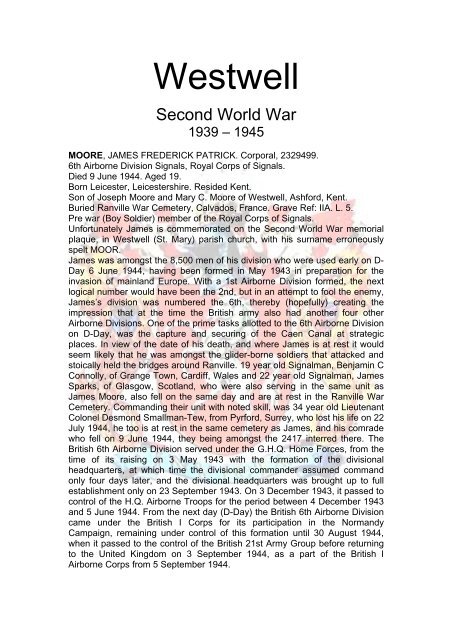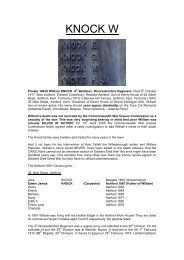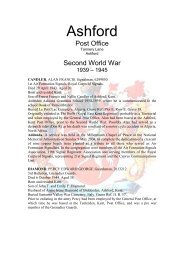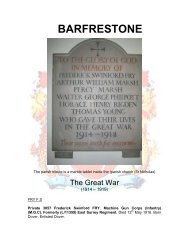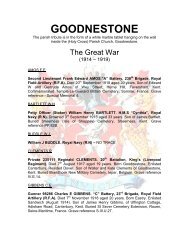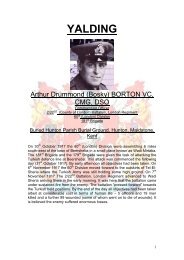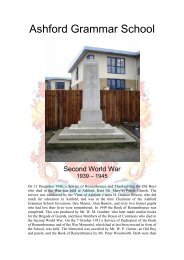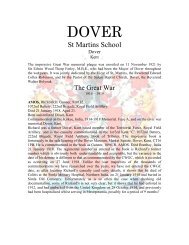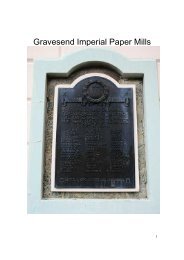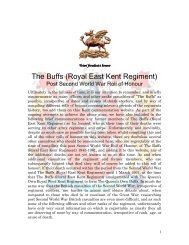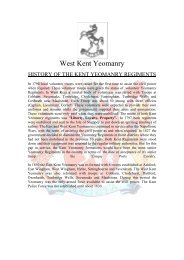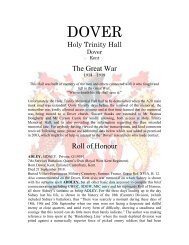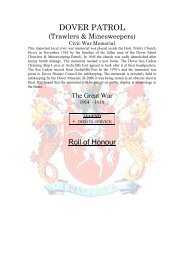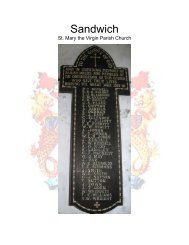Create successful ePaper yourself
Turn your PDF publications into a flip-book with our unique Google optimized e-Paper software.
<strong>Westwell</strong><br />
Second World War<br />
1939 – 1945<br />
MOORE, JAMES FREDERICK PATRICK. Corporal, 2329499.<br />
6th Airborne Division Signals, Royal Corps of Signals.<br />
Died 9 June 1944. Aged 19.<br />
Born Leicester, Leicestershire. Resided <strong>Kent</strong>.<br />
Son of Joseph Moore and Mary C. Moore of <strong>Westwell</strong>, Ashford, <strong>Kent</strong>.<br />
Buried Ranville War Cemetery, Calvados, France. Grave Ref: IIA. L. 5.<br />
Pre war (Boy Soldier) member of the Royal Corps of Signals.<br />
Unfortunately James is commemorated on the Second World War memorial<br />
plaque, in <strong>Westwell</strong> (St. Mary) parish church, with his surname erroneously<br />
spelt MOOR.<br />
James was amongst the 8,500 men of his division who were used early on D-<br />
Day 6 June 1944, having been formed in May 1943 in preparation for the<br />
invasion of mainland Europe. With a 1st Airborne Division formed, the next<br />
logical number would have been the 2nd, but in an attempt to fool the enemy,<br />
James’s division was numbered the 6th, thereby (hopefully) creating the<br />
impression that at the time the British army also had another four other<br />
Airborne Divisions. One of the prime tasks allotted to the 6th Airborne Division<br />
on D-Day, was the capture and securing of the Caen Canal at strategic<br />
places. In view of the date of his death, and where James is at rest it would<br />
seem likely that he was amongst the glider-borne soldiers that attacked and<br />
stoically held the bridges around Ranville. 19 year old Signalman, Benjamin C<br />
Connolly, of Grange Town, Cardiff, Wales and 22 year old Signalman, James<br />
Sparks, of Glasgow, Scotland, who were also serving in the same unit as<br />
James Moore, also fell on the same day and are at rest in the Ranville War<br />
Cemetery. Commanding their unit with noted skill, was 34 year old Lieutenant<br />
Colonel Desmond Smallman-Tew, from Pyrford, Surrey, who lost his life on 22<br />
July 1944, he too is at rest in the same cemetery as James, and his comrade<br />
who fell on 9 June 1944, they being amongst the 2417 interred there. The<br />
British 6th Airborne Division served under the G.H.Q. Home Forces, from the<br />
time of its raising on 3 May 1943 with the formation of the divisional<br />
headquarters, at which time the divisional commander assumed command<br />
only four days later, and the divisional headquarters was brought up to full<br />
establishment only on 23 September 1943. On 3 December 1943, it passed to<br />
control of the H.Q. Airborne Troops for the period between 4 December 1943<br />
and 5 June 1944. From the next day (D-Day) the British 6th Airborne Division<br />
came under the British I Corps for its participation in the Normandy<br />
Campaign, remaining under control of this formation until 30 August 1944,<br />
when it passed to the control of the British 21st Army Group before returning<br />
to the United Kingdom on 3 September 1944, as a part of the British I<br />
Airborne Corps from 5 September 1944.
DANTON. HAROLD VINCENT. Private, 6285834.<br />
1/5th Battalion, The Queen’s Royal Regiment (West Surrey).<br />
Died Western Europe Campaign 1 April 1945. Aged 25. Born Wiltshire.<br />
Resided <strong>Kent</strong>.<br />
Commemorated on <strong>Westwell</strong>, Ashford, <strong>Kent</strong> war memorial.<br />
Buried Reichswald Forest War Cemetery, Kleve, Nordrhein-Westfalen,<br />
Germany.<br />
Grave Ref: 55. D. 10.<br />
Pre war member of The Buffs (Royal East <strong>Kent</strong> Regiment).<br />
ROBINS, JOHN RUMNEY. Lieutenant (A).<br />
Royal Navy, H.M.S. Ark Royal.<br />
Died 1 August 1940. Aged 33.<br />
Son of Dr John Norman Robins and Muriel Winifred Robins of Folkestone,<br />
<strong>Kent</strong>.<br />
Buried Medjez-el-Bab War Cemetery, Tunisia. Grave Ref: 18. G. 5.<br />
As John was a naval airman and in view of where he is at rest, it is possible<br />
that his body was later recovered from the sea, after he had lost his life during<br />
an attack at 0230 hours. H.M.S. Ark Royal launched an air strike with twelve<br />
Swordfish torpedo bombers, led by Lieutenant-Commander G. B. Hodgkinson<br />
on Cagliari, Sardinia. The aerodrome installations were damaged during the<br />
raid, but two of the Swordfish were lost.<br />
SKINNER. JACK. D.F.C. Warrant Officer (Pilot), 1332584.<br />
Royal Air Force Volunteer Reserve.<br />
Died 19 March 1945. Aged 21.<br />
Born 1923 Little Chart, Ashford, <strong>Kent</strong>.<br />
Son of Frank and Mary Skinner of <strong>Westwell</strong>, <strong>Kent</strong>.<br />
Jack attended Ashford (Boys)Grammar School between 1934 and 1939,<br />
where he is commemorated in the Second World War, Book of<br />
Rememberance.<br />
Buried Oxford (Botley) Cemetery, Oxfordshire. Grave Ref: Plot H/1. Grave<br />
226.<br />
At the time of his demise Jack was an instructor based at R.A.F. Brize Norton,<br />
Oxfordshire, training other pilots to tow aircraft and died resultant of an<br />
accident towing a glider. R.A.F. Brize Norton, was used for various forms of<br />
flying training until July 1942, when it became the home of the Heavy Glider<br />
Conversion Unit (H.G.C.U.), later being renamed No. 21 H.G.C.U., which<br />
remained at R.A.F. Brize Norton until 31 December 1945.<br />
CLARK, HUGH MAXWELL. Pilot Officer (Observer), 69469.<br />
Royal Air Force Volunteer Reserve. 82 Squadron, Royal Air Force.<br />
Died 12 August 1941. Aged 24.<br />
Son of Douglas Edward and Dorothy Clark of <strong>Westwell</strong>, Ashford, <strong>Kent</strong>.<br />
Buried Strijen Protestant Cemetery, Zuid-Holland (South-Holland),<br />
Netherlands. Grave Ref: 10.<br />
Hugh was a crew member of Blenheim Bomber T2437 UX-Y which took off<br />
from Bodney, Norfolk on 12 August 1941 as one of 54 Blenheim’s sent on a<br />
daring low level daylight raid to bomb power stations at Quadrath and<br />
Knapsack near Köln (Cologne), Hugh’s aircraft being amongst those assigned
Quadrath as the prime target, near the targets the Blenheim’s came under<br />
intense fire from flak guns which resulted ultimately in the loss of 10 of them<br />
including Hugh’s aircraft which crashed at 1210 hours in the Hoekse Waard<br />
polder it being about seven miles south west of Dortrecht, Holland, killing the<br />
three crew, one of the reasons for the raid was to try and draw enemy aircraft<br />
away from the Eastern Front and thereby helping to alleviate the pressure on<br />
the Russians.<br />
Hugh’s comrades who perished with him Graham Rolland and Ernest<br />
Bainbridge are buried each side of him and were both Lancastrians.<br />
STROVER, PERCY ELVY. Private, 5504437.<br />
1st Battalion, Hampshire Regiment.<br />
Died 10 October 1944. Aged 25.<br />
Born and resided <strong>Kent</strong>.<br />
Son of William and Elizabeth Strover.<br />
Husband of Betty R Strover of Coulsden, Surrey.<br />
Also commemorated on Ashford (<strong>Kent</strong>) civic war memorial.<br />
Buried Arnhem Oosterbeek War Cemetery, Gelderland, Netherlands.<br />
Grave Ref:9. A. 9.<br />
Percy is at rest in the grave next to Joseph Hadlum from Ashford, <strong>Kent</strong>, who<br />
also served in the Hampshire Regiment but in a different battalion. Joseph<br />
was also a former pupil of the Ashford North County Modern Boys School,<br />
where Percy is remembered as Percy Elvey Strover. Percy attended the<br />
school from 1929 to 1933 at which time he resided at Buck Street, Challock,<br />
Ashford, <strong>Kent</strong>. Following his enlistment in 1940, Percy first fought in Burma<br />
before being sent to the European war theatre. His younger brother Bert Elvey<br />
Strover who thankfully survived the Second World War, was also an ex pupil<br />
of ‘The North’ (1934-1937), and he served in the R.E.M.E. as a Driver from<br />
1941, and saw action in France, Belgium, Holland and Germany, during the<br />
Western Europe Campaign.
DYGRÝN, JOSEF. D.F.M. Warrant Officer (Pilot), 787678.<br />
Royal Air Force Volunteer Reserve.310 (Czechoslovak) Squadron, Royal Air<br />
Force.<br />
Born Prague, Czechoslovakia 6 March 1918.<br />
Died 4 June 1942. Aged 24.<br />
Buried <strong>Westwell</strong>, Ashford, <strong>Kent</strong> Burial Ground. Grave Ref: 243.<br />
Josef was one of ‘The Few,’ being amongst the 87 of his countrymen who<br />
flew in the ‘Battle of Britain’ flying a Hurricane, whilst serving as a Sergeant<br />
(Pilot) in 1 and 85 Squadrons, Royal Air Force. Although the former was not<br />
officially a Czechoslovak squadron it did have a significant number of<br />
Czechoslovakian airmen serving in it. Following his retraining on a Hawker<br />
Hurricane after reaching the United Kingdom, Josef was initially posted to 85<br />
Squadron, R.A.F. on 14 October 1940 which at the time was based at Church<br />
Fenton, North Yorkshire. Only a week later Josef transferred to No.1<br />
Squadron, R.A.F. where he remained for eleven months apart from a period<br />
of nearly a fortnight in November/December 1940. Josef’s posting to No.1<br />
Squadron got away to a somewhat disastrous and inauspicious start, as on 30<br />
October 1940 whilst landing, he damaged Hurricane I N2433, it being<br />
resultant of inadvertently setting the aircrafts flaps in the wrong position.<br />
Despite the early blip, in his time with the squadron Josef more than<br />
compensated for the repair costs to the damaged aircraft, as on the night on<br />
10/11 May 1941 he took off from R.A.F. Redhill, Surrey in Hurricane IIA<br />
Z3687, to engage a German mixed bomber formation that was heading for<br />
London, and before Josef returned to land his aircraft, he had shot down three<br />
of the enemy aircraft. At 0035 hours whilst above the capital Josef engaged<br />
and destroyed a Heinkel HE 111, he brought down another of the same make<br />
and type about an hour and twenty minutes later, when it was above Gatwick,<br />
Sussex, and at 0325 he engaged a Junkers JU88 close to Biggin Hill airfield,<br />
<strong>Kent</strong>, which he also shot down. On 23 September 1941 Josef was posted to<br />
join his fellow Czechs of 310 (Czechoslovak) Squadron, R.A.F. based at<br />
Dyce, Aberdeenshire, Scotland, and served with them until May 1942. After<br />
his time with 310 (Czechoslovak) Squadron, R.A.F., he was once more<br />
posted to No. 1 Squadron, R.A.F. which was then based at R.A.F. Tangmere,<br />
Sussex, and became involved in the squadron’s “Intruder” operations. It was<br />
whilst Josef was engaged on an “Intruder” flight to Evreux-Fauville airfield<br />
flying Hurricane IIC Z3183 that he was shot down on 4 June 1942, probably<br />
by a German flak gun battery near Le Harve. Josef crashed in the English<br />
Channel, and just over three months later on 8 September his body was<br />
recovered from the sea at Worthing, Sussex, and later interred in the burial
ground at <strong>Westwell</strong>, Ashford, <strong>Kent</strong>. Like several servicemen serving with the<br />
British forces in the United Kingdom (and elsewhere), who were from Nazi<br />
occupied countries, Josef used an alias or “war surname” which in his case<br />
was Ligotický. For his gallantry, the British awarded him the Distinguished<br />
Flying Medal, in addition to which he also held bravery awards from his native<br />
land, they being the War Cross 1939, and Medal for Valour, which he was<br />
awarded whilst still a Sergeant, In addition to the ‘kills’ mentioned above he<br />
scored two others and also shared in the destruction of another enemy<br />
aircraft, which made him the fifth highest scoring Czechoslovakian nightfighter<br />
pilot serving in the Royal Air Force. Sincere thanks are due to Rabekka<br />
Hrbacek, of Vinohradská, Czech Republic, for providing some of the above<br />
information, and also the photograph of Josef Dygrýn.


